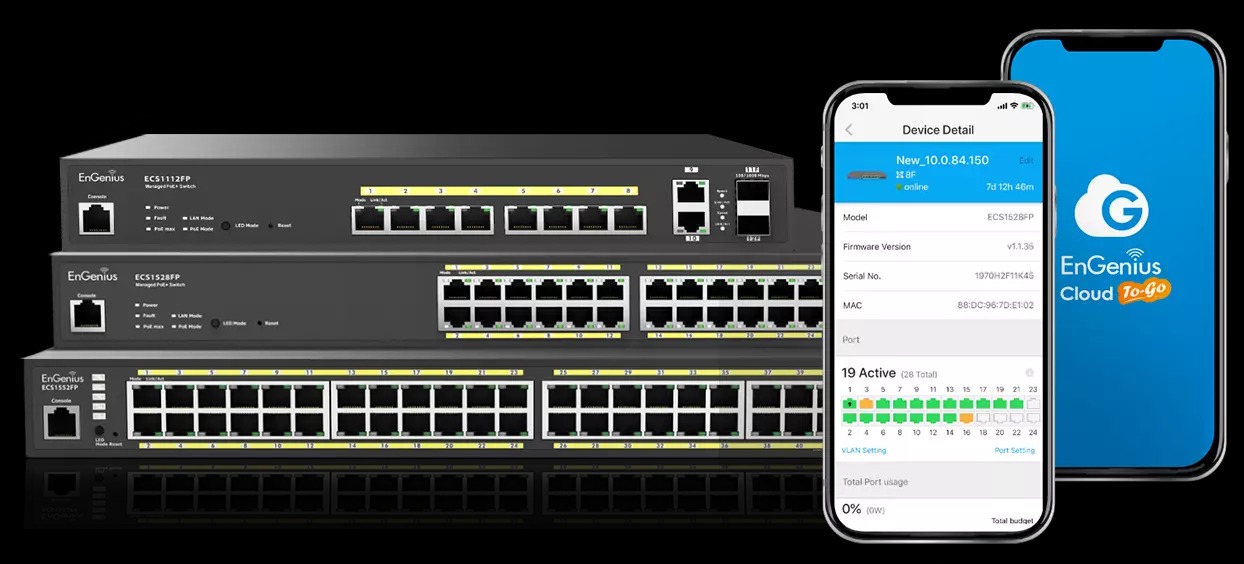The EnGenius ECS2512FP is the entry-level PoE++ Ethernet switch in the multi-Gig series and I realize that this may seem like an understatement, as the device has eight 2.5 GbE Ethernet ports, four 10 Gbps SFP+ slots and full support for the EnGenius cloud management platform.
In addition, the PoE++ (802.3 bt) support ensures that the EnGenius ECS2512FP can handle the most power-hungry wireless access points, but was it really necessary when the ports are limited to 2.5 GbE? More importantly, the EnGenius ECS2512FP does not go as high as 100W, but only UP to 60W per Port with a maximum PoE budget of 240W. If you think that is not enough, just know that the ZyXEL WAX650S, the only access point I tested that required a PoE++ switch to work at full power, only required 31W.

There are not many PoE++ access points yet (and maybe due to the high power consumption, few are being developed in the era of desired energy efficiency), but The EnGenius ECS2512FP should be excellent for powering several other switches (I’m looking forward to if EnGenius develops something With a Cloud Ethernet switch, standalone mode usually offers very few settings, but this is not the cover here, because the ECS2512FP offers almost the entire range of features, even without a cloud connection.
At the same time, the cloud platform allows you to monitor and configure a larger number of EnGenius devices. However, let’s take a closer look at the EnGenius ECS2512FP and see if upgrading your Gigabit Ethernet switch is worth it.
Quality of design and manufacture
After taking the EnGenius ECS2512FP out of the box, I found that it was identical to the ECS1112FP in terms of size, with both switches measuring 13.0 x 9.0 x 1.7 inches (or 33.0 x 23.0 x 4.4 cm). And this is not a surprise, considering that these Ethernet switches were designed to be mounted in a Rack–you get the brackets and screws inside the box.
 Yes, there are rubber feet (which you can attach to the bottom of the switch) to suggest otherwise, but while the ECS1112FP was just a little noisy because of the internal fan, the EnGenius ECS2512FP will make a ruckus. This is because there is a pair of fans on the left side of the cover that always seem to be running at maximum speed. It won’t be a problem if the device is sitting on a Rack, but while I was testing it, it got so loud that it affected the sound quality of some open headphones.
Yes, there are rubber feet (which you can attach to the bottom of the switch) to suggest otherwise, but while the ECS1112FP was just a little noisy because of the internal fan, the EnGenius ECS2512FP will make a ruckus. This is because there is a pair of fans on the left side of the cover that always seem to be running at maximum speed. It won’t be a problem if the device is sitting on a Rack, but while I was testing it, it got so loud that it affected the sound quality of some open headphones.
So yes, it is a mandatory Rack Ethernet switch. The good news is that all these noises are not in vain, because the thermal management is good even if you connect several PoE devices. Of course, it will be a little hot near the main chips and near the connectors (which is normal if the manufacturer uses the metal cover itself to dissipate heat), but the fans will keep everything under control.
And yes, the cover is all metal, including the front area (it’s not just a plastic piece glued to the frame), so it’s also a little heavy (weighs 5.7 pounds or 2.6 kg). On the front, at least the left part is pretty much identical to the EnGenius ECS1112FP, which means that there is a console connector (you get a console cable in the box) followed by a row of LEDs. There is the power indicator (lit in solid green) and an error light that should remain off.Otherwise, an error has occurred with the switch when it turns red.
You also get the LAN mode and the POE mode LEDs that tell you that you have (or are not using) devices that use PoE to turn on (there is a button that allows you to switch between the modes). There is the PoE Max LED that lights up once you have reached the maximum allowed Budget-240 W in total; and there is also a reset button recessed next to the LED.

In the center are eight 10/100/1000/2500 Base – T GbE Ethernet ports supporting 802.3 af/at/bt PoE++ (with the 60 W limit mentioned in the Intro). Of course, the more devices you add, the less the Budget is available. The last four ports support 10 Gbps, but these are SFP+ slots.You must therefore use a compatible module to take advantage of this power.
Note: EnGenius itself offers SFP+ transceiver modules that can go up to 300 meters (about 1,000 feet) or even up to 10 km (6.2 miles).




